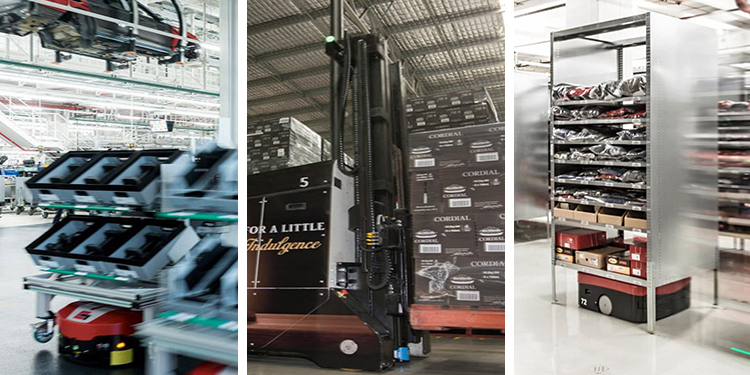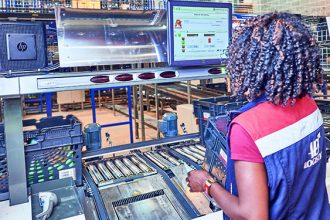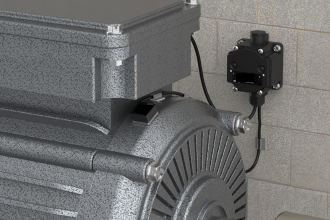How Mobile Autonomous Vehicles Address E-Commerce, Automotive And Food/Beverage Handling Challenges

Operations considering an investment in mobile autonomous vehicles (MAVs) — such as automatic guided vehicles (AGVs) and autonomous mobile robots (AMRs) — have lots of questions. Among them: How will the system work in my application? What types of challenges can MAVs most successfully address? and, How will the system impact employees and processes?
To answer these questions, the Mobile Automation Group (MAG) of MHI offers an educational session entitled “Applications Segmented By Subdivisions.” The 40-minute presentation shares case studies about deployments of these technologies in distribution, fulfillment, and manufacturing operations across three industry sectors: retail/e-commerce, automotive, and food/beverage. It details the versatility of MAV technologies, as well as their ability to deliver benefits to multiple industry segments.
Retail/E-Commerce
Retail and e-commerce facilities are challenged by the need to grow by saving time, saving money or selling more product. Yet selling more products increases throughput volumes, which — in a manual operation — requires more labor productivity. Because people don’t scale and are costly, it is important to maximize their time by supporting them with tools and technologies that allow them to do their jobs better and more efficiently.
By applying automated MAV technologies to retail and e-commerce fulfillment processes, an operation can:
- Reduce manual workloads and redundant tasks
- Simply front-end and back-end workflows
- Eliminate disconnected silos of automation
- Scale for growth quickly and efficiently
As an example, the presentation shares the experience of a third-party logistics (3PL) service provider who sought an automated solution to help manage returns more effectively. It was determined that goods-to-person (G2P) automation would be the optimal solution. However, because they were limited by their existing facility’s low ceiling height, a high-bay automated storage and retrieval system (ASRS) would not fit into the operation. Instead, they deployed 75 bots to tunnel under and transport 800 storage racks, bringing them to five separate G2P workstations. This system enabled greater inventory density for storage and buffering of returns; reduced the time it took for returns to be inducted back into available inventory; sped up order processing while increasing order accuracy; and increased overall operational efficiency.
Automotive
Already a long-time user of MAV technologies — and a broad range of other automated solutions — automotive manufacturers implement automation to reduce dependence on a costly workforce, as well as to eliminate human error and ensure precision work. Transporting heavy loads with manned vehicles poses a safety risk to workers on the floor and raises the potential for product damage.
Automating product movement with autonomous, un-manned vehicles offers automotive manufacturers a variety of advantages, including:
- Increased operational efficiency through just-in-time (JIT) delivery of the correct parts line-side
- 24/7 usage and maximum system availability
- Reduced product damage
- Continuous confirmation of each load’s location
- Increased operator safety
The presentation shares two case studies of automotive manufacturers utilizing MAVs. The first, a German vehicle maker, deployed 28 bots to interface with 90 transport tables/carts. Parts required for the shift were pre-staged onto the carts and held in a supermarket area. As needed, the bots delivered the components line-side on a JIT basis; when the operator used the last part, a bot was summoned to remove the empty cart while a different bot brought a full cart to the line. This increased efficiency and safety within the assembly process, as well as improved part accuracy and labor savings.
The second case study details how a tier-one components supplier utilized seven fork AGVs to handle the stacking and unstacking of pallets of containers. The vehicles deliver parts to the line and remove the empty containers after the contents are depleted. Motivated by forklift accidents that had resulted in worker injuries, the operation’s automated vehicles have reduced forklift traffic and associated labor costs while increasing process efficiency and safety.
Food/Beverage
Food and beverage handlers are continuously pressured to be flexible as product manufacturers and retailers perpetually change their offerings to meet shifting consumer demands. Brand and stock keeping unit (SKU) proliferation is a constant, while specials and promotions can prompt spikes in inventory that require dynamic and flexible handling processes. Further, product damage and high worker turnover are common issues in these facilities.
Adding automated technologies, such as MAVs, to address these challenges can help food and beverage facilities:
- Reduce product damage
- Move materials more cost-effectively and flexibly
- Improve safety
- Overcome labor shortages/turnover
Case studies of two beverage handlers are offered as examples of such implementations. The first, a soft drink manufacturer, replaced forklifts with five fork AGVs to transport stretch-wrapped pallets of product from palletizers at the end of the production line to a destination determined by the warehouse management system (WMS). Based on a scan of the pallet’s license plate, the AGV would be directed to block stack the load, place it in selective rack, or deliver it to the dock for outbound shipping. As a result, the operation experienced improvements in productivity, efficiency and safety while reducing labor costs and damage to both product and facility.
In the second example, a sports beverage manufacturer deployed 15 fork AGVs to reduce labor and automate repetitive, mundane tasks — including truck loading. Instead of operator driven forklifts, automated vehicles transport pallet loads from the production line to high bay warehouse storage locations, as well as retrieve loads from storage for outbound shipping. Additionally, they are programmed for automatic truck loading as directed by the facility’s WMS. With the AGVs in place, the operation has experienced a reduction in labor costs, product damage and facility damage, while improving productivity, efficiency, safety and handling flexibility.
Want additional insights into how MAVs can help your operation address key challenges? The members of MHI’s Mobile Automation Group (MAG) are available for additional insights and guidance in determining if the technology is right for your processes and how to successfully implement it. Additionally, the group offers a variety of resources for those who wish to learn more about this type of automation — including case studies, white papers, cost estimating guidance and more — on its website, mhi.org/mag.



